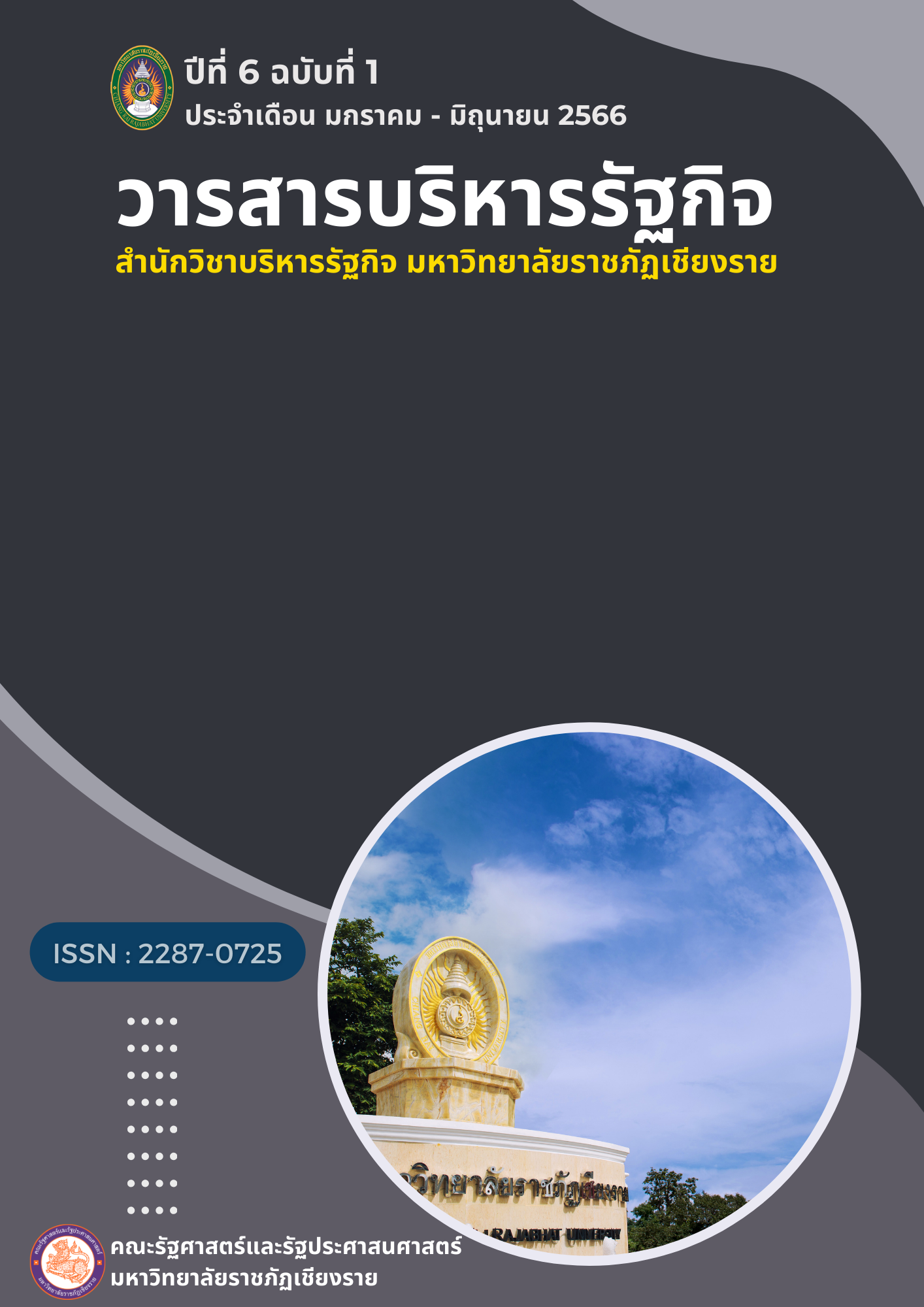Components of Competitiveness of Small and Medium Businesses Case of Covid 19 Crisis
Main Article Content
Abstract
The objectives of this article are: To study the components of competitiveness of SMEs in the case of the Covid-19 crisis by the components of competitiveness of small and medium businesses Case of the COVID-19 crisis in the study of knowledge, concepts, and theories involved From documents and research, there are two components: Element 1, low cost vs. Element 2, differentiation. There are three sub-components of differentiation, namely, Element 2.1 Differentiation in marketing mix strategy, Component 2.2 Quality Differentiation and Component 2.3 Marketing Differentiation.
Article Details
References
ดนชนก เบื่อน้อย. (2559). นวัตกรรมกับความคิดสร้างสรรค์. วารสารวิชาการการตลาดและการจัดการ มหาวิทยาลัยเทคโนโลยีราชมงคลธัญบุรี, 3(1), 1-12.
ทิบดี ทัฬหกรณ์ และธีระวัฒน์ จันทึก. (2560). การสร้างผู้ประกอบการรุ่นใหม่ในยุคไทยแลนด์4.0. RMUTT Global Business & Economics Review, 12(2), 107-122.
ศฐิฒฎา ธารารัตนสุวรรณ. (2563). ผลกระทบเชื้อไวรัส COVID-19 ต่อวิกฤตการท่องเที่ยวของประเทศไทย. กรุงเทพฯ: สำนักวิชาการ สำนักงานเลขาธิการวุฒิสภา.
สำนักงานส่งเสริมวิสาหกิจขนาดกลางและขนาดย่อม. (2563). บทสรุปผู้บริหาร รายงานสถานการณ์วิสาหกิจขนาดกลางและขนาดย่อม ปี 2563. สืบค้นเมื่อวันที่ 18 ตุลาคม 2563. จาก http://www.sme.go.th/th/download.php?modulekey=215.
อาคีรา ราชเวียง. (2560). อนาคตผู้ประกอบการในยุค 4.0. วารสารวิจัยและพัฒนาวไลยอลงกรณ์ในพระบรมราชูปถัมภ์สาขามนุษยศาสตร์และสังคมศาสตร์, 12(2), 79-88.
Beal, R. M. and M. Yasai-Ardekani. (2000). Performance Implications of Aligning CEO Functional Experiences with Competitive Strategies. Journal of Management, 26(4), 733-762.
Bohan, George P., and Nicholus F. Horney. (1991). Pinpointing the Real Cost of Quality In a Service Company. National Productivity Review (Summer).
Campanella, J. (1990). Principles of quality costs (2nded.). Milwaukee, WI: ASQC Quality Press.
Chin-Sheng, C. (2017). Price Discrimination in Input Markets and Quality Differentiation. Springer.
Chuangphusri, P. & Buranasing, S. (2011). Conflict Management and Crisis Management. Bangkok: Prince Damrong Rajanuphap Institute.
Chuanlin, D., & Li, Z. (2014). A Comparative Study on Hotel Services Marketing Differentiation between Beijing and Taipei. Service Systems and Service Management (ICSSSM), 2014 11th International Conference.
Crossan, M. M., & Apaydin, M. (2010). A Multi-Dimensional Framework of Organizational Innovation: A Systematic Review of the Literature. Journal of Management Studies, 47, 1154-1191.
Davol, N. B., Mayor, M.G., and Luisa, M. & Hera, B. D. (2011). Empirical analysis of technological innovation capacity and competitiveness in EU-15 countries. African Journal of Business Management, 5(14), 5753-5765.
Dean, J.W., & Evans, J.R. (1994). Total quality: Management, organization, and strategy.
St. Paul, MN: West Publishing Company.
Dess, G. G., Lumpkin. G. T., & Eisner, A. B. (2007). Strategic management: Text & Case (3rded.). Boston: McGraw-Hill.
Garvin, D. A. (1984). What does “Product Quality” really mean?. Sloan Management Review, 26(1), 25-43.
Grant, R M. (1991). The resource-based theory of competitive advantage: implication for strategy Formula. California Management Review, 33(3), 14-35.
Herédia-Colaço, V., & Rodrigues, H. (2021). Hosting in turbulent times: Hoteliers’ perceptions and strategies to recover from the Covid-19 pandemic. International Journal of Hospitality Management, 94(102,835), 1-12.
Jose, F. M-A, Juan, J. T, Jorge, P-M, María, D. L-G, Eva, M. P-O. (2015). The effects of quality and environmental management on competitive advantage: A mixed methods study in the hotel industry. Tourism Management. 50(15), 41-54.
Kay, A. L., & Gulzar, H. S. (2016). An Iterative, Low-Cost Strategy to Building Information Systems Allows a Small Jurisdiction Local Health Department to Increase Efficiencies and Expand Services. Journal of Public Health Management and Practice, 22(6), 95-100.
Lai, I.K. W., & Wong, J. W.C. (2020). Comparing crisis management practices in the hotel industry between initial and pandemic stages of COVID-19. International Journal of Contemporary Hospitality Management, 32(10), 3135-3156.
Leonidas, C. L., Thomas, A. F., Paul, C., Stavroula, S., & Constantine, S. K. (2015). Environmentally friendly export business strategy: Its determinants and effects on competitive advantage and performance. International Business Review, 24, 798-811.
Li, Y & Xie, W. (2013). Study on the Comparison of Competiveness of Heilongjiang SMEs Based on Factor Analysis Method. Journal English edition copyright DOI: 10.5503.
Min-Jae, Jeongki, and Jun-Young. (2015). The Effect of Cooperation-Strategy Fit on the Performance of Subcontractors-Focused on Samsung Electronics’ Subcontractors. JOEBM 2015, 3(3), 370-376.
Porter, M. (1980). Competitive Strategy. Free Press: New York.
Porter, M. (1985). Competitive Advantage. Creating and Sustaining Superior Performance, Free Press, New York.
Raduan, C. R., Haslinda, A., & Alimin, I. I. (2010). A Review on the Relationship between Organizational Resources, Competitive Advantage and Performance. The Journal of International Social Research, 3(11), 490-498.
Robert A. Baron and Jintong Tang. (2011). The role of entrepreneurs in firm-level innovation: Joint effects of positive affect, creativity and environmental dynamism. Journal of Business Venturing, 26, 49-60.
Roland, T. R., Christine, M., & Dickson, P. R. (2002). Getting return on quality: Revenue expansion, cost reduction, or both. Journal of Marketing, 66(4), 7-24.
Yi-Ru, R. C. (2017). Perceived values of branded mobile media, consumer engagement, business-consumer relationship quality and purchase intention: A study of We Chat in China. Public Relations Review, 43, 945–954.


